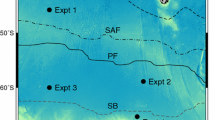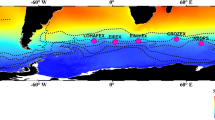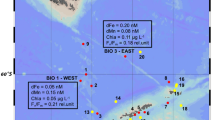Abstract
In “high nitrate, low chlorophyll” (HNLC) ocean regions, iron has been typically regarded as the limiting factor for phytoplankton production. This “iron hypothesis” needs to be tested in various oceanic environments to understand the role of iron in marine biological and biogeochemical processes. In this paper, three in vitro iron enrichment experiments were performed in Prydz Bay and at the Polar Front north of the Ross Sea, to study the role of iron on phytoplankton production. At the Polar Front of Ross Sea, iron addition significantly (P<0.05, Student’s t-test) stimulated phytoplankton growth. In Prydz Bay, however, both the iron treatments and the controls showed rapid phytoplankton growth, and no significant effect (P>0.05, Student’s t-test) as a consequence of iron addition was observed. These results confirmed the limiting role of iron in the Ross Sea and indicated that iron was not the primary factor limiting phytoplankton growth in Prydz Bay. Because the light environment for phytoplankton was enhanced in experimental bottles, light was assumed to be responsible for the rapid growth of phytoplankton in all treatments and to be the limiting factor controlling field phytoplankton growth in Prydz Bay. During the incubation experiments, nutrient consumption ratios also changed with the physiological status and the growth phases of phytoplankton cells. When phytoplankton growth was stimulated by iron addition, N was the first and Si was the last nutrient which absorption enhanced. The Si/N and Si/P consumption ratios of phytoplankton in the stationary and decay phases were significantly higher than those of rapidly growing phytoplankton. These findings were helpful for studies of the marine ecosystem and biogeochemistry in Prydz Bay, and were also valuable for biogeochemical studies of carbon and nutrients in various marine environments.
Similar content being viewed by others
References
Watson A J. Iron limitation in the oceans. In: Turner D R, Hunter K A, eds. The Biogeochemistry of Iron in Seawater. Chichester: John Wiley and Sons, 2001. 7–38
Martin J H, Fitzwater S E. Iron-deficiency limits phytoplankton growth in the northeast Pacific Subarctic. Nature, 1988, 331: 341–343
de Baar H J W, de Jong J T M, Bakker D C E, et al. Importance of iron for plankton blooms and carbon dioxide drawdown in the Southern Ocean. Nature, 1995, 373: 412–415
Martin J H, Fitzwater S E. Iron in Antarctic waters. Nature, 1990, 345: 156–158
Buma A G J, de Baar H J W, Nolting R F, et al. Metal enrichment experiments in the Weddell-Scotia Seas: Effects of Fe and Mn on various plankton communities. Limnol Oceanogr, 1991, 36: 1865–1877
Timmermans K R, van Leeuwe M A, de Jong J T M, et al. Iron limitation in the Pacific region of the Southern Ocean: Evidence from enrichment bioassays. Mar Ecol Prog Ser, 1998, 166: 27–41
Boyd P W, Watson A J, Cliff C S, et al. A mesoscale phytoplankton bloom in the polar Southern Ocean stimulated by iron fertilization. Nature, 2000, 407: 695–702
Olson R J, Sosik H M, Chekalyuk A M, et al. Effects of iron enrichment on phytoplankton in the Southern Ocean during late summer: Active fluorescence and flow cytometric analyses. Deep-Sea Res II, 2000, 47: 3181–3200
Coale K H, Wang X, Tanner S J, et al. Phytoplankton growth and biological response to iron and zinc addition in the Ross Sea and Antarctic Circumpolar Current along 170°W. Deep-Sea Res II, 2003, 50: 635–653
Löscher B W, de Baar H J W, de Jong J T M, et al. The distribution of Fe in the Antarctic Circumpolar Current. Deep-Sea Res II, 1997, 44: 143–187
Martin J H, Coale K H, Johnson K S, et al. Testing the iron hypothesis in ecosystems of the equatorial Pacific Ocean. Nature, 1994, 123–129
Planquette H, Statham P J, Fones G R, et al. Dissolved iron in the vicinity of the Crozet Islands, Southern Ocean. Deep-Sea Res II, 2007, 54: 1999–2019
Fitzwater S E, Johnson K E, Gordon R M, et al. Trace metal concentrations in the Ross Sea and their relationships with nutrients and phytoplankton growth. Deep-Sea Res II, 2000, 47: 3159–3179
de Baar H J W, Buma A G J, Nolting R F, et al. On iron limitation of the Southern Ocean: Experimental observations in the Weddell and Scotia Seas. Mar Ecol Prog Ser, 1990, 65: 105–122
Hutchins D A, Bruland K W. Iron-limited diatom growth and Si:N uptake ratio in a coastal upwelling regime. Nature, 1998, 393: 561–564
Takeda S. Influence of iron availability on nutrient consumption ratio of diatoms in oceanic waters. Nature, 1998, 393: 774–777
Muggli D L, Lecourt M, Harrison P J. Effects of iron and nitrogen source on the sinking rate, physiology and metal composition of an oceanic diatom from the subarctic Pacific. Mar Ecol Prog Ser, 1996, 132: 215–227
Zhang W, Sun S, Zhang Y, et al. Iron enrichment incubation ex- periments in Prydz Bay, Antarctic (in Chinese with English Abstract). Chin J Pol Res, 15(4): 238–248
Boyd P W, Muggli D L, Varela D E, et al. In vitro iron enrichment experiments in the NE subarctic Pacific. Mar Ecol Prog Ser, 1996, 136: 179–193
Banse K. Does iron really limit phytoplankton in the offshore subarctic Pacific. Limnol Oceanogr, 1990, 35: 772–775
Banse K. Rates of phytoplankton cell-division in the field and in iron enrichment experiments. Limnol Oceanogr, 1991, 36: 1886–1898
Cullen J J. Hypotheses to explain high-nutrient conditions in the open sea. Limnol Oceanogr, 1991, 36: 1578–1599
Dugdale R C, Wilkerson F P. Iron addition experiments in the Antarctic: A re-analysis. Global Biogeochem Cycles, 1990, 4: 13–19
Cochlan W P, Bronk D A, Coale K H. Trace metals and nitrogenous nutrition of Antarctic phytoplankton: Experimental observations in the Ross Sea. Deep-Sea Res II, 2002, 49: 3365–3390
Martin J H, Fitzwater S E, Gordon R M. Iron deficiency limits phytoplankton growth in Antarctic water. Glob Biogeochem Cycles, 1990, 4: 5–12
Martin J H, Gordon R M, Fitzwater S E. The case of iron. Limnol Oceangr, 1991, 36: 1793–1802
Price N M, Ahner B A, Morel F M M. Iron and nitrogen nutrition of equatorial Pacific plankton. Deep-Sea Res I, 1991, 38: 1361–1378
Raven J. Predictions of Mn and Fe use efficiencies of phototrophic growth as a function of light availability for growth and of C assimilation pathway. New Phytol, 1990, 116: 1–18
Sunda W G, Huntsman S A. Interrelated influence of iron, light, and cell size on marine phytoplankton growth. Nature, 1997, 390: 389–392
Smetacek V, de Baar H J W, Bathmann U V, et al. Ecology and biogeochemistry of the Antarctic Circumpolar Current during austral spring: A summary of Southern Ocean JGOFS cruise ANT X/6 of R.V. Polarstern. Deep-Sea Res II, 1997, 44: 1–21
de Baar H J W, Boyd P M. The role of iron in plankton ecology and carbon dioxide transfer of the global oceans. In: Hanson R B, Ducklow H W, Field J G, eds. The Dynamic Ocean Carbon Cycle: A Midterm Synthesis of the Joint Global Ocean Flux Study, International Geosphere Biosphere Programme Book Series V5. Cambridge: Cambridge University Press, 2000. 61–140
de Baar H J W, van Leeuwe M A, Scharek R, et al. Nutrient anomalies in Fragilariopsis kerguelensis blooms, iron deficiency and the nitrate/phosphate ratio (A.C. Redfield) of the Antarctic Ocean. Deep-Sea Res II, 1997, 44: 229–260
van Leeuwe M A, Scharek R, de Baar H J W, et al. Iron enrichment experiments in the Southern Ocean: Physiological responses of plankton communities. Deep-Sea Res II, 1998, 44: 189–207
Bucciarelli E, Blain S, Treguer P. Iron and manganese in the wake of the Kerguelen Islands (Southern Ocean). Mar Chem, 2001, 73(1): 21–36
Johnson K S, Chavez F P, Friederich G E. Continental-shelf sediment as a primary source of iron for coastal phytoplankton. Nature, 1999, 398: 697–700
Martin J H, Broenkow W W, Fitzwater S E, et al. Does iron really limit phytoplankton production in the offshore sub-arctic Pacific-Yes, it does — A reply. Limnol Oceanogr, 1990, 35: 775–777
Pu S, Dong Z, Hu Y, et al. Water masses and their northward extension in the upper ocean of Prydz Bay, Antarctica (in Chinese with English Abstract). Chin J Pol Res, 2000, 12(3): 157–168
Pu S, Dong Z. Progress in physical oceanographic studies of Prydz bay and its adjacent oceanic area (in Chinese with English Abstract). Chin J Pol Res, 2003, 15(1): 52–63
Sedwick P N, DiTullio G R. Regulation of algal blooms in Antarctic shelf water by the release of iron from melting sea ice. Geophys Res Lett, 1997, 24: 2515–2518
Liu Z, Cai Y, Ning X, et al. Primary production and standing stock of phytoplankton in the Prydz Bay and the adjacent northern sea area during the austral summer of 1999/2000 (in Chinese with English Abstract). Chin J Pol Res, 2001, 13(1): 1–12
Hu C, Zhang H, Pan J, et al. The biogeochemistry of the carbon cycle in summer at Prydz Bay, Antarctica. II: Characteristics of POC distribution (in Chinese with English Abstract). Chin J Pol Res, 2001, 13(3): 195–204
Chen Z, Wang Y, Liu J. The depletion of nutrients and the estimate of the new production in the ice-edge in Prydz Bay, Antarctica (in Chinese with English Abstract). Chin J Pol Res, 1998, 10(3): 204–211
Martin-Jézéquel V, Hildebrand M, Brzezinski M A. Silicon metabolism in diatoms: Implications for growth. J Phycol, 2000, 36: 821–840
Hilderbrand M. Lack of coupling between silicon and other elemental metabolisms in diatoms. J Phycol, 2002, 38: 841–843
Pascal C, Martin-Jezequel V, Kromkamp J C, et al. Uncoupling of silicon compared with carbon and nitrogen metabolisms and the role of the cell cycle in continuous cultures of Thalassiosira pseudonana (Bacillariophyceae) under light, nitrogen, and phosphorus control. J Phycol, 2002, 38: 922–930
Author information
Authors and Affiliations
Corresponding author
Additional information
Supported by National Key Technology Research and Development Program (Grant No. 2006BAB18B07) and the Polar Year Project of the Department of Science and Technology of China
Rights and permissions
About this article
Cite this article
Sun, S., Pu, X. & Zhang, Y. In vitro iron enrichment experiments in the Prydz Bay, the Southern Ocean: A test of the iron hypothesis. Sci. China Ser. D-Earth Sci. 52, 1426–1435 (2009). https://doi.org/10.1007/s11430-009-0141-9
Received:
Accepted:
Published:
Issue Date:
DOI: https://doi.org/10.1007/s11430-009-0141-9




